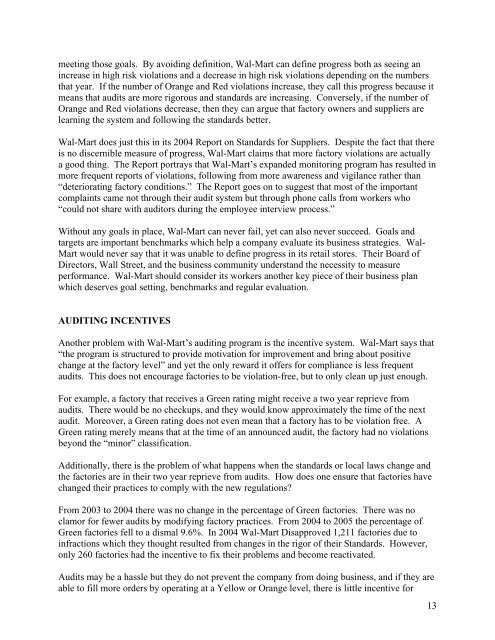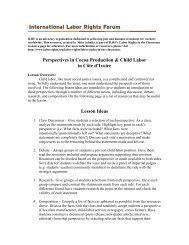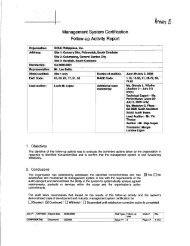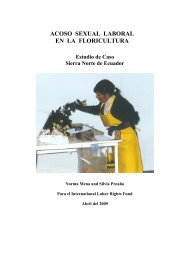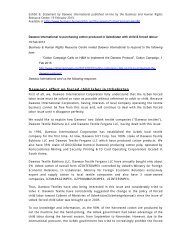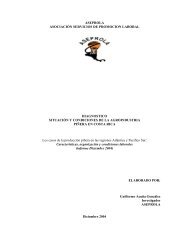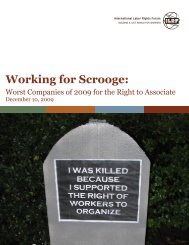Ethical Standards and Working Conditions in Wal-Mart's Supply Chain
Ethical Standards and Working Conditions in Wal-Mart's Supply Chain
Ethical Standards and Working Conditions in Wal-Mart's Supply Chain
Create successful ePaper yourself
Turn your PDF publications into a flip-book with our unique Google optimized e-Paper software.
meet<strong>in</strong>g those goals. By avoid<strong>in</strong>g def<strong>in</strong>ition, <strong>Wal</strong>-Mart can def<strong>in</strong>e progress both as see<strong>in</strong>g an<strong>in</strong>crease <strong>in</strong> high risk violations <strong>and</strong> a decrease <strong>in</strong> high risk violations depend<strong>in</strong>g on the numbersthat year. If the number of Orange <strong>and</strong> Red violations <strong>in</strong>crease, they call this progress because itmeans that audits are more rigorous <strong>and</strong> st<strong>and</strong>ards are <strong>in</strong>creas<strong>in</strong>g. Conversely, if the number ofOrange <strong>and</strong> Red violations decrease, then they can argue that factory owners <strong>and</strong> suppliers arelearn<strong>in</strong>g the system <strong>and</strong> follow<strong>in</strong>g the st<strong>and</strong>ards better.<strong>Wal</strong>-Mart does just this <strong>in</strong> its 2004 Report on <strong>St<strong>and</strong>ards</strong> for Suppliers. Despite the fact that thereis no discernible measure of progress, <strong>Wal</strong>-Mart claims that more factory violations are actuallya good th<strong>in</strong>g. The Report portrays that <strong>Wal</strong>-Mart’s exp<strong>and</strong>ed monitor<strong>in</strong>g program has resulted <strong>in</strong>more frequent reports of violations, follow<strong>in</strong>g from more awareness <strong>and</strong> vigilance rather than“deteriorat<strong>in</strong>g factory conditions.” The Report goes on to suggest that most of the importantcompla<strong>in</strong>ts came not through their audit system but through phone calls from workers who“could not share with auditors dur<strong>in</strong>g the employee <strong>in</strong>terview process.”Without any goals <strong>in</strong> place, <strong>Wal</strong>-Mart can never fail, yet can also never succeed. Goals <strong>and</strong>targets are important benchmarks which help a company evaluate its bus<strong>in</strong>ess strategies. <strong>Wal</strong>-Mart would never say that it was unable to def<strong>in</strong>e progress <strong>in</strong> its retail stores. Their Board ofDirectors, <strong>Wal</strong>l Street, <strong>and</strong> the bus<strong>in</strong>ess community underst<strong>and</strong> the necessity to measureperformance. <strong>Wal</strong>-Mart should consider its workers another key piece of their bus<strong>in</strong>ess planwhich deserves goal sett<strong>in</strong>g, benchmarks <strong>and</strong> regular evaluation.AUDITING INCENTIVESAnother problem with <strong>Wal</strong>-Mart’s audit<strong>in</strong>g program is the <strong>in</strong>centive system. <strong>Wal</strong>-Mart says that“the program is structured to provide motivation for improvement <strong>and</strong> br<strong>in</strong>g about positivechange at the factory level” <strong>and</strong> yet the only reward it offers for compliance is less frequentaudits. This does not encourage factories to be violation-free, but to only clean up just enough.For example, a factory that receives a Green rat<strong>in</strong>g might receive a two year reprieve fromaudits. There would be no checkups, <strong>and</strong> they would know approximately the time of the nextaudit. Moreover, a Green rat<strong>in</strong>g does not even mean that a factory has to be violation free. AGreen rat<strong>in</strong>g merely means that at the time of an announced audit, the factory had no violationsbeyond the “m<strong>in</strong>or” classification.Additionally, there is the problem of what happens when the st<strong>and</strong>ards or local laws change <strong>and</strong>the factories are <strong>in</strong> their two year reprieve from audits. How does one ensure that factories havechanged their practices to comply with the new regulations?From 2003 to 2004 there was no change <strong>in</strong> the percentage of Green factories. There was noclamor for fewer audits by modify<strong>in</strong>g factory practices. From 2004 to 2005 the percentage ofGreen factories fell to a dismal 9.6%. In 2004 <strong>Wal</strong>-Mart Disapproved 1,211 factories due to<strong>in</strong>fractions which they thought resulted from changes <strong>in</strong> the rigor of their <strong>St<strong>and</strong>ards</strong>. However,only 260 factories had the <strong>in</strong>centive to fix their problems <strong>and</strong> become reactivated.Audits may be a hassle but they do not prevent the company from do<strong>in</strong>g bus<strong>in</strong>ess, <strong>and</strong> if they areable to fill more orders by operat<strong>in</strong>g at a Yellow or Orange level, there is little <strong>in</strong>centive for13


